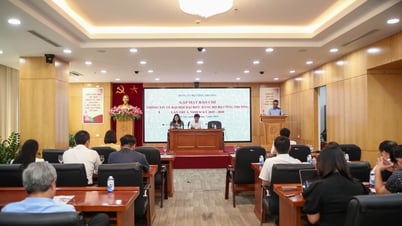Gastrointestinal stromal tumor (GIST) if not detected and treated promptly can cause some acute complications such as bleeding, intestinal obstruction, intestinal torsion, intestinal perforation causing peritonitis.
Mr. H., 33 years old, had gastroesophageal reflux, bitter mouth, went to the doctor and found a tumor near the esophagus, the doctor had to calculate carefully, cut and reconnect the esophagus with the stomach to eradicate the cancer.
 |
| Gastrointestinal stromal tumor (GIST) if not detected and treated promptly can cause some acute complications such as bleeding, intestinal obstruction, intestinal torsion, intestinal perforation causing peritonitis. |
Mr. H. (address in Ho Chi Minh City) has no pain, no weight loss, all activities and eating are normal. He was quite surprised to know that he had this dangerous disease with only a bitter mouth symptom.
Abdominal computed tomography (CT) scan results showed a tumor measuring 21 x 30 x 27 mm in the cardia (located at the end of the esophagus and the beginning of the stomach) that had not invaded surrounding tissue and no lymph nodes appeared. Gastroscopy also showed that the patient had gastritis and gastroesophageal reflux.
However, because the tumor is located under the gastric mucosa, at the back of the stomach, it is not possible to biopsy the tumor during endoscopy. Therefore, the nature of the tumor has not been determined. The tumor is located in a hidden location, so it is not possible to intervene during endoscopy.
However, surgery to remove the tumor is needed as soon as possible to avoid the tumor from growing and blocking the esophagus. Or if the tumor is malignant, the cancer cells can invade neighboring organs.
Mr. H. was prescribed medication to treat gastroesophageal reflux and inflammation for 2 weeks before surgery. During the surgery, the doctors simultaneously performed an abdominal ultrasound and a gastroscopy to accurately determine the tumor.
After determining the location of the tumor, the doctor uses a mobile ultrasonic knife to dissect the esophagus, cutting across the esophagus 2 cm above the tumor and across the stomach 3 cm below the tumor. Then, the esophagus-stomach is connected.
Postoperatively, the patient's health recovered well and he was able to eat liquid foods gradually transitioning to solid foods. Five days after surgery, the patient recovered well, the wound was stable and he was discharged from the hospital. The tumor was removed for pathological anatomy and immunohistochemistry.
As a result, the tumor has a low risk of becoming malignant, so no further treatment is required. The patient should have regular health check-ups for monitoring.
Specialist Doctor 2 Nguyen Quoc Thai, Center for Endoscopy and Endoscopic Surgery of Digestive System, Tam Anh General Hospital, Ho Chi Minh City said that submucosal tumors of the digestive tract are tumors originating from the muscular-mucosal layer, submucosal layer or muscular layer of the digestive tract wall.
Submucosal tumors are small, round lesions that protrude into the lumen of the digestive tract and are covered by a normal mucosal layer. They can occur anywhere in the digestive tract. However, they are most common in the stomach and are discovered incidentally during gastroscopy or colonoscopy.
Usually, tumors under 2 cm are asymptomatic and are only monitored. However, submucosal tumors can cause bleeding, gastrointestinal obstruction or metastasis depending on the size, location and nature of the tumor.
Gastrointestinal stromal tumor (GIST) if not detected and treated promptly can cause some acute complications such as bleeding, intestinal obstruction, intestinal torsion, intestinal perforation causing peritonitis (usually occurs when the tumor is larger than 4 cm).
It can even cause death due to gastrointestinal bleeding. Common symptoms of GIST are vomiting blood, bloody stools, or black stools, fatigue, dizziness, fainting, and anemia of unknown cause.
Intestinal obstruction or torsion due to GIST often presents with abdominal cramps, loss of appetite, vomiting, nausea, constipation, indigestion, inability to defecate, bloody stools or black stools. The most dangerous is intestinal perforation (a rare complication) which causes severe abdominal pain.
Doctor Quoc Thai said, GIST is a common mesenchymal tumor, accounting for 0.1 - 3% of all malignant tumors in the digestive tract. Submucosal tumors are usually benign (accounting for 85%), only 15% are malignant.
GISTs form when cells lining the digestive tract multiply out of control. Most of these GISTs are associated with mutations in the KIT gene.
This gene stimulates cells to make a protein called KIT CD117, which speeds up uncontrolled growth and division.
In addition, there are very few risk factors associated with GIST such as people aged 50 years or older, genetic inheritance from parents to children, neurofibromatosis type 1, Carney-Stratigakis syndrome (a rare genetic disease).
Because this is a disease unrelated to lifestyle or diet, it cannot be prevented. Patients need to proactively have regular health check-ups, and seek medical attention immediately when unusual symptoms appear for timely examination, diagnosis, and treatment to prevent dangerous complications.
Source: https://baodautu.vn/phat-hien-ung-thu-chi-voi-trieu-chung-dang-mieng-d223447.html


































































































Comment (0)